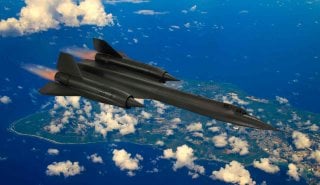The SR-71 Blackbird Is Remembered for More Than Speed and Stealth
The Lockheed Martin SR-71 “Blackbird” still holds the world record as the fastest manned jet aircraft ever constructed, with an official top speed of Mach-3.3 (times the speed of sound).
The fastest aircraft to ever roam the skies may surprise you. While newer fighter jets like the U.S.-made F-22 Raptor or F-35 Lightning II probably come to mind, the record for speed actually belongs to a Cold War-era spy plane. The Lockheed Martin SR-71 “Blackbird” still holds the world record as the fastest manned jet aircraft ever constructed, with an official top speed of Mach 3.3 (times the speed of sound). Born from the infamous Skunk Works division at Lockheed, the SR-71 remains a favorite among aviation buffs and military experts alike.
The origins of the Blackbird
As the Cold War between the United States and USSR was heating up, U.S. policymakers desired new aerial platforms that could circumvent the Soviets’ advanced air defense systems. The resulting spy plane was the U-2. Nicknamed the “Dragon Lady,” this airframe successfully flew several missions over Soviet airspace when first introduced. However, in 1960, a U-2 flown by CIA pilot Francis Powers was shot down by the USSR’s SA-2 surface-to-air missile (SAM). Although the mission to develop an even faster successor to the U-2 was already in the works prior to this incident, the loss of Powers’ aircraft highlighted the urgency of those efforts.
Unsurprisingly, the SR-71’s design was heavily influenced by Skunk Work’s Kelly Johnson. Perhaps the most innovative and qualified aircraft designer of the time, Kelly’s vision helped shape the Blackbird we know today. The task of creating the SR-71 was unique, since “everything had to be invented,” according to Johnson. The two major concepts that were prioritized in the Blackbird design process were high speeds and a minimized radar cross-section. The theory was that this combination of stealth and speed would make it nearly impossible for even the most advanced Soviet SAMs to shoot down.
What made the SR-71 stand out?
Since the Blackbird was designed to fly at speeds in excess of Mach 3.0 in order to avoid anti-aircraft fire, friction became a grave concern to Skunk Works engineers. In order to contend with the friction that would result from flying at such fast speeds, titanium was selected as a material because this ceramic-based metal is able to withstand such high temperatures. A CNN report detailed the issues surrounding the use of titanium: “First, a whole new set of tools – also made of titanium – had to be fabricated, because regular steel ones shattered the brittle titanium on contact. Second, sourcing the metal itself proved tricky. The USSR was, at the time, the greatest supplier of titanium in the world. The US government had to purchase a lot of that, probably using bogus companies.”
Despite these hurdles, a fleet of SR-71s was designed. By the early 1970s, the first Blackbird conducted a round-trip mission over Israel to verify the Israeli Defense Force’s nuclear aviation. Additional Blackbird airframes flew over Egypt, Syria, and Lebanon to gather intelligence about the positions of Israel and its Arab neighbors during this timeframe. In fact, the United States was able to use the imagery captured by the Blackbird airframes to help end the Yom Kippur War.
While the Blackbird platform has been phased out over the years, the legendary platform retains its status as the fastest jet to ever fly the skies.
Maya Carlin is a National Interest security contributor, an analyst with the Center for Security Policy, and a former Anna Sobol Levy Fellow at IDC Herzliya in Israel. She has by-lines in many publications, including The National Interest, Jerusalem Post, and Times of Israel.
Image: Shutterstock.

